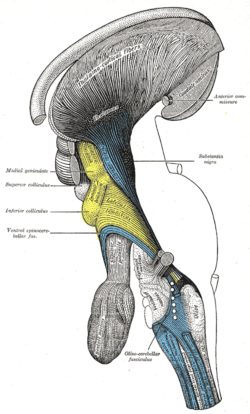Tectum
| Tectum | |
|---|---|
 Deep dissection of brain-stem. Lateral view. | |
| Details | |
| Part of | Midbrain |
| Identifiers | |
| Latin | tectum |
| NeuroNames | 465 |
| NeuroLex ID | birnlex_1032 |
| TA | A14.1.06.601 |
| TH | H3.11.03.3.01001 |
| TE | E5.14.3.3.1.4.1 |
| FMA | 83902 |
| Anatomical terms of neuroanatomy | |
The tectum (Latin: roof) is a region of the brain, specifically the dorsal (top) part of the midbrain (mesencephalon).[1] The position of the tectum is contrasted with the tegmentum, which refers to the region ventral (lower) to the ventricular system. The tectum is responsible for auditory and visual reflexes.
It is derived in embryonic development from the alar plate of the neural tube.
Structure
In adult humans, it only consists of the inferior and the superior colliculi.
- The superior colliculus is involved in preliminary visual processing and control of eye movements. In non-mammalian vertebrates it serves as the main visual area of the brain, functionally analogous to the visual areas of the cerebral cortex in mammals.
- The inferior colliculus is involved in auditory processing. It receives input from various brain stem nuclei and projects to the medial geniculate nucleus of the thalamus, which relays auditory information to the primary auditory cortex.
Both colliculi also have descending projections to the paramedian pontine reticular formation and spinal cord, and thus can be involved in responses to stimuli faster than cortical processing would allow. Collectively the colliculi are referred to as the corpora quadrigemina.
The structure is supplied by quadrigeminal artery (a branch of posterior cerebral artery), and superior cerebellar artery.
Related terms
The term "tectal plate" (or "quadrigeminal plate") is used to describe the junction of the gray and white matter in the embryo. (ancil-453 at NeuroNames)
Additional images
- Tectum
See also
References
- ↑ Bear, Mark F.; Connors, Barry W.; Paradiso, Michael A. (2007). Neuroscience. Lippincott Williams & Wilkins. ISBN 9780781760034.
External links
| Wikimedia Commons has media related to Midbrain tectum. |
- Diagram
- Photo
- "Anatomy diagram: 13048.000-3". Roche Lexicon - illustrated navigator. Elsevier. Archived from the original on 2014-01-01.